Thanks to Frontier Developments for providing Goonhammer with a Steam code for review purposes.
While there have been a few PC games set in the Age of Sigmar, none have made much of a splash. Warhammer Age of Sigmar: Realms of Ruin aims to change that with a showy real-time strategy (RTS) game, replete with a story-based campaign, competitive multiplayer, and a suite of customization options.
Audio and Visuals
I’ll cut to the chase and say this: Realms of Ruin looks good. Pulled back from a distance, everything looks fantastic, and it’s worth zooming in to examine the animations, facial tics, and fastidious attention to detail. There are certainly games with more detailed graphics out there, but what’s here more than gets the job done, and perfectly captures the source material. Everything looks and moves the way I would imagine it would on the tabletop, and the environments they fight over are suitably fantastical. At the ground level, I can see my Vanguard-Hunters twirling their axes, glancing around the environment as Ghurish vines and leaves move about them.
The UI is minimal – this game was made for consoles as well, and as a result there isn’t quite as much information as you may get from other RTS games. There’s no stats available for units. Nowhere does it say a Liberator does 25-30 damage and has 200HP or anything an RTS diehard would expect. Instead, a shield icon signifies that Liberators have a tank role, and that’s about it. This opaqueness and commitment to easily recognizable icons was likely done to help ease players new to the RTS genre into the game. I don’t need to see all the stats to make my decisions – I’d assume the more expensive guys with a sword icon are better than the cheaper ones – but I would like access to some of that information, even in a Help menu somewhere. For now, when it’s implied that a unit of Kruleboyz is more durable than a unit of Hobgrots, I’ll just have to take their word for it.
The Realms of Ruin soundscape is generally great. The voice cast is full of people you’ve definitely seen or heard somewhere before; TV actors and voice over artists you’ll recognize from Broadchurch and Horizon Forbidden West to Hilda and the Mountain King. That experience shines, as they bring loads of character to everyone from named heroes in the campaign to your rank and file Kruleboyz and Vanguard-Hunters. They have the opportunity to really act in the fully mocapped cutscenes, and there are some genuine moments of emotion as the story goes on. I love good unit barks and audio cues, and this game is laden with them. “Some of da boyz is very dead” is going to live with me for a minute. The music sets a serious tone and adequately accompanies the action, but doesn’t stand out. Warhammer game soundtracks have been filled with bangers these past few years, and standing up to Darktide or Mechanicus‘ soundtracks is a tall order. The roars, magic blasts, and din of battle all sound like you’d think they should, and everything is placed just right in the audio mix.
I have a fairly beefy computer, albeit one that’s a couple years old, and I could run the game on max settings. The only dropped frames I ever ran into were when an especially powerful charge would hit a big clump of units, sending bodies ragdolling every which way. The map editor had my computer running hot, but otherwise it was a generally smooth experience with short load times. I ran into some bugs, but I’ll get to those further on.
Gameplay
Gameplay should be familiar to anyone who has played Relic’s Dawn of War or Company of Heroes games. You have four factions to choose from – the Stormcast Eternals, Orruk Kruleboyz, Disciples of Tzeentch, and Nighthaunt. Each plays differently, with unique mechanics that make each faction feel distinct. You control squads of troops and individual heroes and monsters, each of whom have a unique ability or two. These are always mapped to the same keys, which makes using them intuitive. As squads take casualties, you can retreat them to your home base, where they’ll heal up and replenish lost numbers. Said central base building lets you build and upgrade units, and spend resources to expand your tech tree and unit choices.
You’ll pay for all this with two resources – Command and Realmstone. Arcane Conduits are scattered around the map, and as you capture them you can construct various outposts to either expand visibility, grant extra resources, heal your troops, or defend the area. To echo my previous point, if you’ve played Relic’s RTS offerings you should feel right at home. There is a control mechanic here which isn’t very well explained in-game, where the longer a unit stands on one of these, the greater the amount of control, and the greater amount of resources are gathered. This means if you have a Conduit generating Realmstone, it’ll generate more if you camp out some of your dudes on it until it hits 100%. Conversely, an enemy unit can stand on it, draining it down to 0% and cutting off your resources. I wish this control percentage slowly regenerated automatically, as having your dudes babysit an objective isn’t my favorite use of troops in a game that emphasis frontline combat.
Said combat is the Sigmarite-clad meat of the game, and is fairly micro-heavy. Units are broken down into a rock-paper-scissors counter system, with tanky shield units countering lighter sword units, sword units charging and countering ranged units, and ranged units happily plinking away at shield units – provided their targets are in their firing arc. Outside this triangle are hero units, who can effectively deal with most other units but are limited by being single models. All of these units have abilities ripped straight from the tabletop, often sharing names and functionalities with their inspiration. Careful timing and placement of these abilities is where battles will be won, as a well-timed charge or snare can easily win or lose a fight. Each use of these costs resources however, so you can’t just spam them and hope for the best. Few are as finnicky as a League of Legends skillshot, and units are generally hardy enough that you can take a moment before unleashing an ability or calling a retreat. Battles feel satisfying to play out, and between the unit barks, visuals, and gameplay, it all feels like Age of Sigmar.
Single Player Campaign
My attention was immediately grabbed at the outset of the campaign. The gates of Harkanibus open and the Stormhost marches out, trudging through the mud and schlepping out into Ghur on foot. All instances of Age of Sigmar lore I’ve encountered, up to and including the very expensive looking launch trailer for 3rd edition, have had the Stormcast hurled to the earth like lightning bolts from Zeus. There’s no bombast or heroics here, just people with a job to do. This Hammers of Sigmar warband is led by Sigrun, her Knight-Vexillor Iden, and the human wizard Demetrios. They’re venturing out to find a MacGuffin that can drive back the relentless Orruk raids and protect the city. Opposing them are Warboss Dankfeer, his Shaman Bludstew, and their jolly green bunch who aren’t too happy about these Tinpots/Stormgitz in their swamp. To my surprise, you find the MacGuffin almost immediately, and through a series of narrative twists, get to take control of most of the game’s factions in short order.
Unlike Warcraft III or others of its ilk, there isn’t a clean divide between the Stormcast campaign, the Orruk campaign, and so on. Instead you bounce between factions every few missions, getting greater context for the story being told. The Disciples of Tzeentch and the Nighthaunt do feature in this story in a way that doesn’t feel out of place, but the crux of the campaign is the war between the Stormcast and the Orruks.
I appreciated the mission variety here; while some missions were just skirmishes with extra set dressing, others featured a finite selection of units, or were stealth missions deep in enemy territory. It wasn’t just an extended tutorial for multiplayer. The campaign is also smartly designed in that it doesn’t have you undoing your previous mission’s progress – you aren’t building a wall in one mission just to tear it down in the next. You’re still likely acting outside the best interests of any given faction when you switch control, but it doesn’t feel self defeating. The campaign lasted me about 9 hours, told its story, and didn’t outstay its welcome. Some character arcs and moments were predictable, others pleasantly surprised me. The whole thing is well voiced, and the acting, choreography, and cinematography in the cutscenes were a pleasure to watch.
Missives from my Inner Beavis and Butt-Head
I’d like to know the thought behind calling the central city Harkanibus. Every time a character would say it, I’d hear “Our cannabis,” which is maybe why Warboss Dankfeer wants to burn it so bad. I was wishing I asked the game’s writers about this naming choice when I interviewed them, but I think I cracked the code.
A Note on Difficulty
I would like to preface this by saying I am no stranger to the RTS genre. I played Command & Conquer before I played Super Mario Bros. I learned to type by inputting cheat codes in Age of Empires before growing out of the need to cheat by the time Star Wars Galactic Battlegrounds came out in 2001. I played 441 ranked matches of Starcraft II, and while I never broke out of Gold League, I felt pretty confident in my skills. I’ve beaten every Dawn of War 1 and 2 campaign, expansions included, at least twice, at all difficulty levels. What I’m trying to say is: I’m decent at RTS games. Realms of Ruin‘s Normal difficulty is very fucking hard. You are almost always being overwhelmed from the 3rd mission onwards, enemies popping up out of literal holes in the ground that cannot be closed. Mission 13 adequately replicated the feeling of getting double turned in Age of Sigmar by someone who is far, far better at the game than you could ever be. I was trapped in my deployment zone, throwing my own maxed population of Orruk idiots into a never-ending stream of Annihilators, Prosecutors, and Evocators. After an hour of this grueling stalemate, I had to turn the game down to Easy, as the difficulty finally got to be too much for me. I did end up completing the campaign after this switch.
Multiplayer
In the Open Beta, there was some grousing about map variety. At launch, multiplayer and skirmish mode have fifteen 1v1 maps, and five for 2v2 team games. The 1v1 maps are also used in Conquest mode, so it’s all the better that the variety largely lives there. Maps have three control points to fight over, as well as a smattering of Arcane Conduits to build outposts on. Matches rarely exceed half an hour, and usually clock in around 20 minutes. These play faster than the single player campaign, with a welcome 30% increase in move speed across all units and all factions.
I played a number of games in skirmish mode, where I was absolutely obliterated by the Medium AI, walked all over Easy, and didn’t even try the harder difficulties. Even on Medium, the AI doesn’t float a single resource, perfectly building units every 20-30 seconds while simultaneously fighting on the front line. In a 2v2 botmatch I would fare better, as my companion Medium AI could shore up what I thought were my pretty decent RTS skills.
As the game unlocked 3 days early for folks who pre-ordered, I got to play a few rounds against live human opponents. Even with this limited pool of potential players, matchmaking was quick. I had a game against someone who was very likely playing on console based on how short and jerky their move commands were. I feel the crossplay feature is a nice thought but doesn’t really work for an RTS game. I tried playing on controller back when I got a hands-on in July, and while it controlled better than any RTS I’ve ever played on a controller, it still doesn’t hold a candle to the speed and precision of playing with a mouse and keyboard. I don’t mean to sound like an elitist with this, and I’m sure some controller wizard out there bury me in 1v1, but I performed far, far better while using a mouse and keyboard. The other games I played ranged from absolute nail-biters to sound victories and defeats, and I felt that old adrenaline surge from my Starcraft II days kick in. The game feels more alive with a human opponent, though I’m glad the AI is there for practice games and long-term play.
Conquest Mode
Much was made about this mode in the preview material, and I even got to mess around with it a smidge in a previous hands-on session. Conquest is a map-based campaign, wherein you’ll fight in a series of random 1v1 matches with extra modifiers, culminating in a final battle. Along the way you’ll earn extra lives, as this is sort of a roguelite gauntlet to the finish. The modifiers in these battles range from minor (slightly increased vision range) to major (removing all but one of the map’s control areas) and can significantly impact the gameplay. It’s a nice changeup and gives some framework to skirmishes with the AI. I do wish there was a little more variety – I played on the same map against the same faction three times in a row, and I would have liked to see some 2v2 botmatches (or even co-op games with a human!) in here too. Some persistent effects or cosmetic rewards on your army over your Conquest campaign would have made it more compelling than just shooting for a high score, but that might be outside the scope and vision of this game mode.
Creative Modes
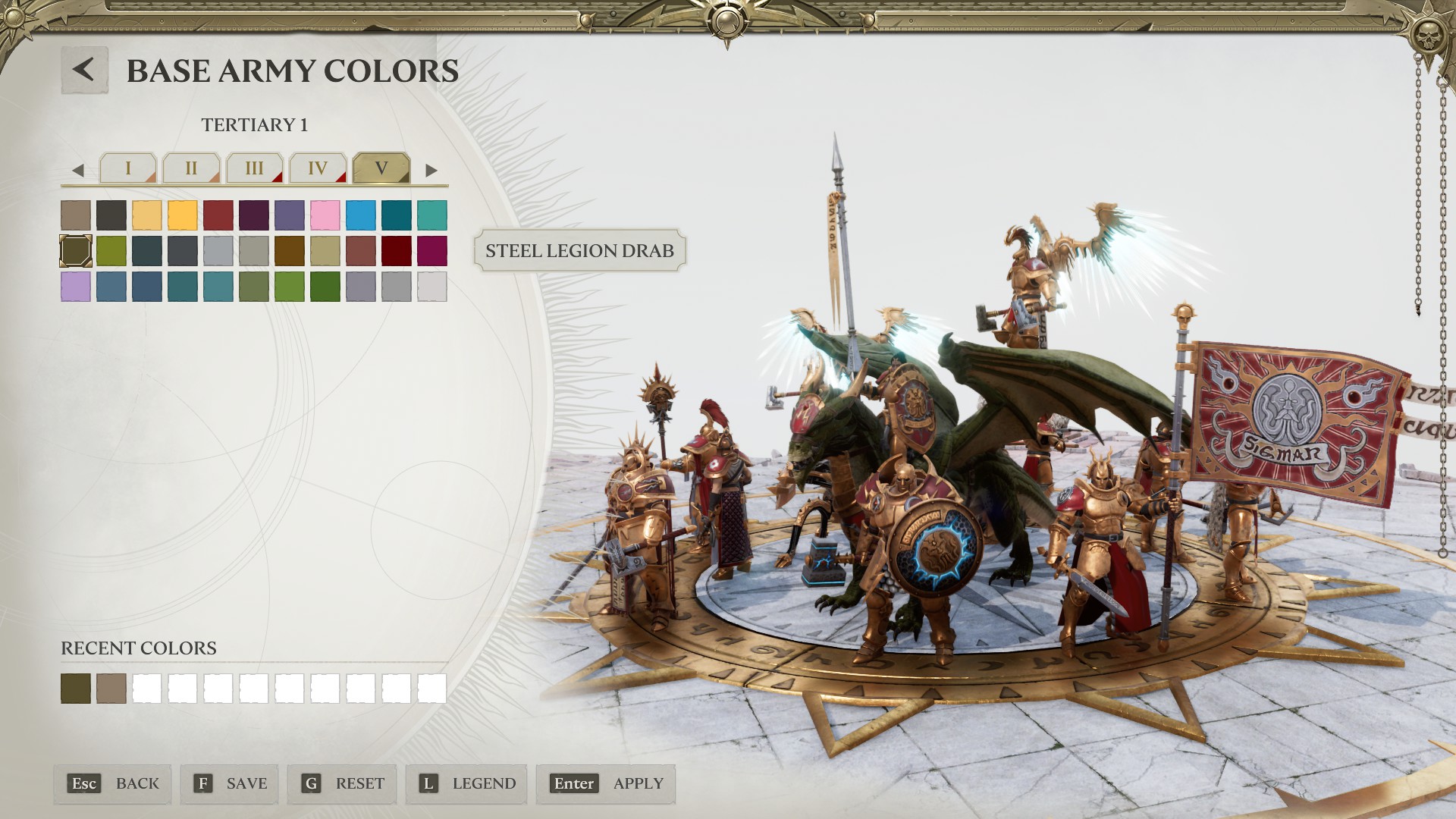
Before playing a single match, I went to the livery editor and customized my Stormcast to look like my own personal Stormhost, The Undying Phalanx. The system works responsively and intuitively, but has a somewhat limited palette. You can also paint individual units, so if you wanted to do the Dark Angels thing and have your Liberators wear green, your Annihilators wear white, and your Prosecutors wear black, you could. You can also customize your multiplayer avatar, the frame around your display name, and so on. It’s nothing as intrusive as Call of Duty but there are plenty of options, with more unlocking as you play.
There is an extensive map editor, with more toggles, switches, and options than I could properly list here. It’s all very intuitive, and even includes a helpful mirroring toggle so you can make a perfectly symmetrical map – great for trying your hand at balanced multiplayer games. It would not shock me one iota if these were just a simplified version of the same tools used to create the maps in-game. You can also place units and characters and position them around to make digital dioramas. This is not a feature for me, but this is likely the first RTS game to have a dedicated photo mode, for whatever that’s worth. What I actually like about this feature is that you can inspect all the character animations, frame by frame, and really take in all the detail that went into them. There are separate animations for getting hit from every which angle, multiple light and heavy attacks, all sorts of stuff that I didn’t totally clock in my hours with the game. Lastly, the maps you make can be uploaded to the Workshop and downloaded by anybody. There is a report button there, so when I see a map with Dickbutt drawn on it in a week, I know its days will be numbered. I downloaded a few of the custom maps that were available at time of reviewing, and the process of making a custom game and selecting those maps is simple as can be. These creative features aren’t really for me – despite being an artist, miniature painter, and avid converter I never really get into this sort of thing in a video game – but I hope a community finds its way into using these tools. The possibilities for custom maps are huge, and I think the core gameplay is good enough to warrant playing on those custom maps for some time to come.
Bugs
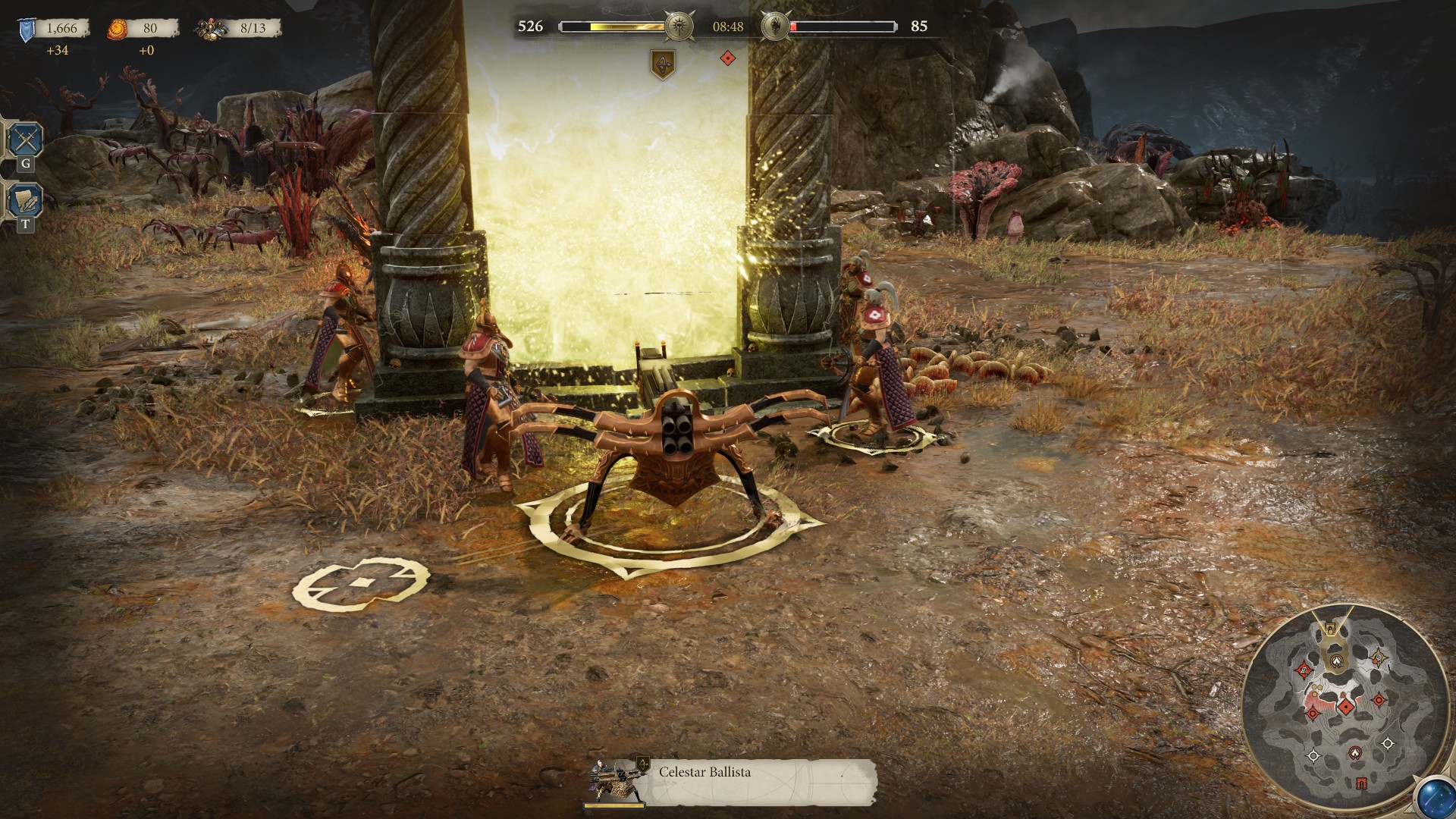
I expect to run into bugs in any game at release, and I ran into a few here. There seems to be a problem with artillery across the board. My Celestar Ballistas would get stuck as they came onto the field, their weapons immobile as the crew danced in circles around my realmgate playing ring around the rosie. Similarly, my Kruleboyz Killbow would slide away on its own volition, leaving the gunner behind. One or two maps have some chokepoints where units will just get stuck, and the pathfinding is very good at finding these bottlenecks. I would randomly get a bug where my keyboard stopped being responsive and the camera got jerky. This was fixed by opening and closing a menu or restarting the game. Most of these are inconveniences that can be played around, but that last one can prove to be deeply frustrating when you’re in a key battle.
Conclusions
You may be able to tell, but I quite like this game. It is not without its flaws, but as both a longtime RTS player and nearly as longtime Warhammer player, I had a good time. There are some things I wish were different – the percentage based control mechanic on Arcane Conduits is not my favorite, and dudes will too often just let their comrades die right next to them without reacting. I wish the campaign difficulty was tweaked for a more even play experience, but I enjoyed the mission variety and the story it was telling. The soundtrack could have been more inspiring, but I loved the voice performances, and the visuals absolutely nailed the setting. The gameplay might be a little simplistic for the hardest of hardcore RTS veterans, but for folks like me who are happy to be in the middle of the pack, you should have a good time. If you’re an Age of Sigmar player, I think it’s absolutely worth a go just to see the setting in motion and see Your Dudes duking it out. The game is packed with features and gameplay modes, and hopefully there’s at least one for you.
Warhammer Age of Sigmar: Realms of Ruin releases on November 17 for PC, PlayStation 5, and Xbox Series X|S.
Have any questions or feedback? Drop us a note in the comments below or email us at contact@goonhammer.com.




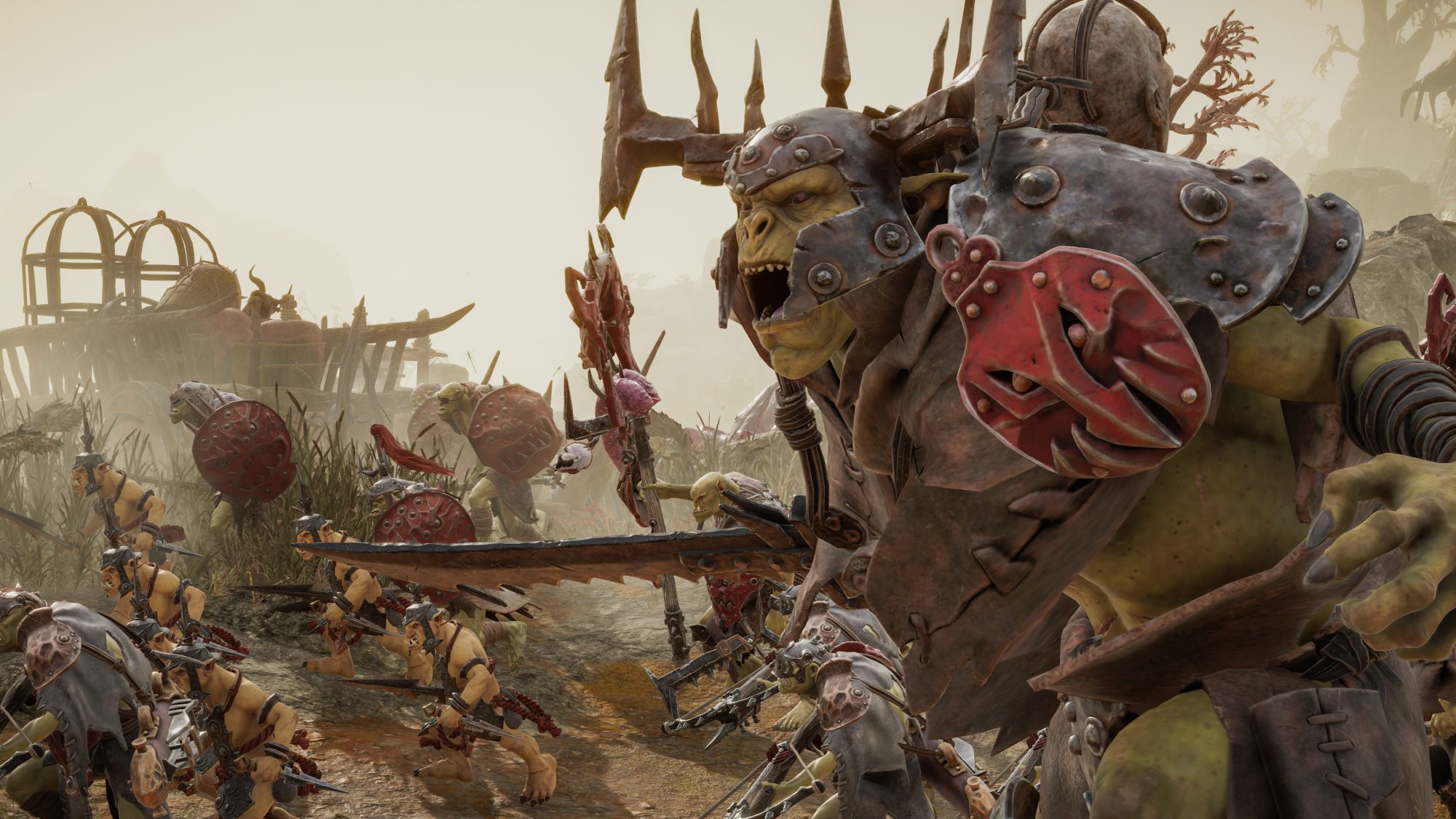
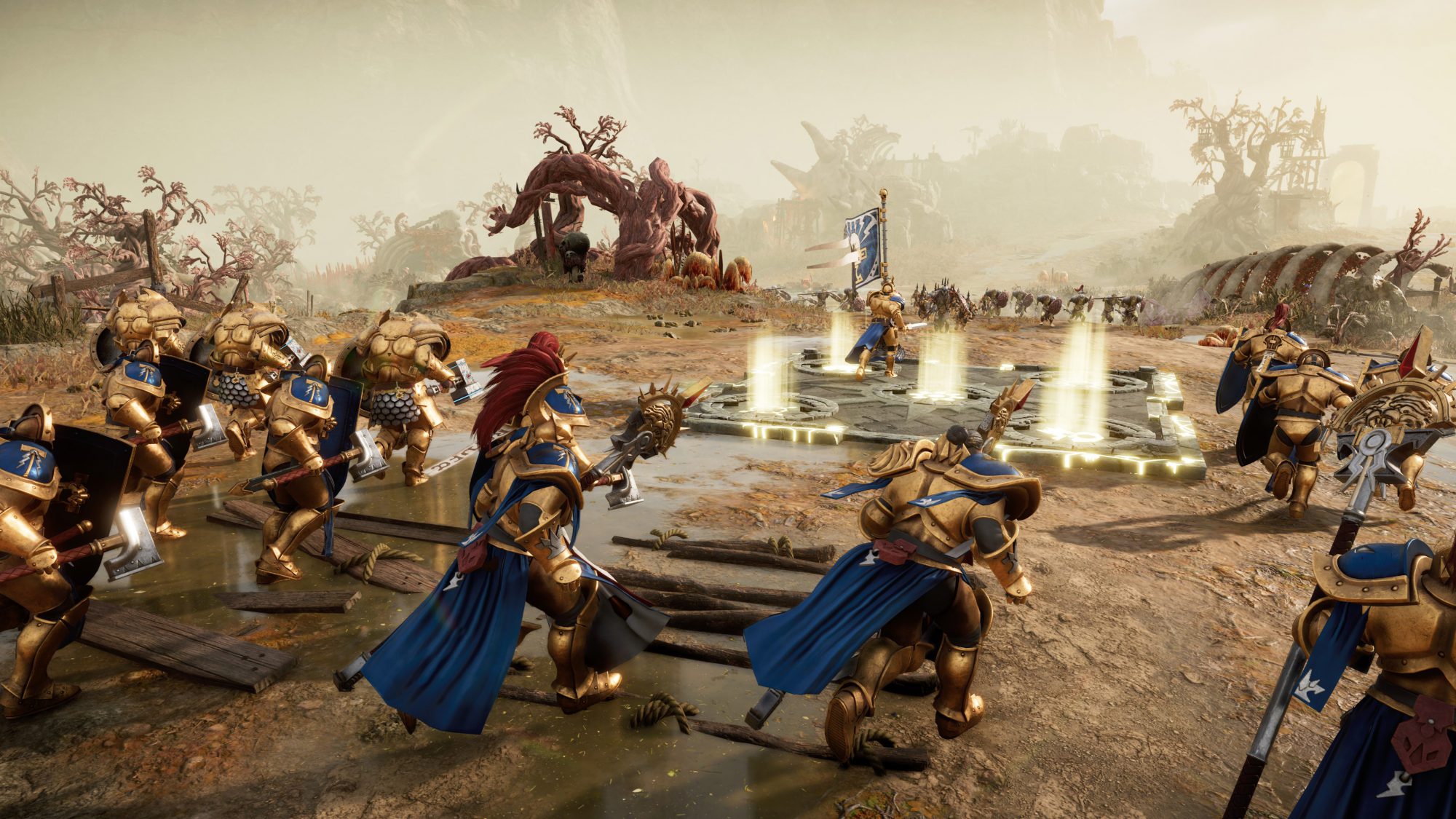
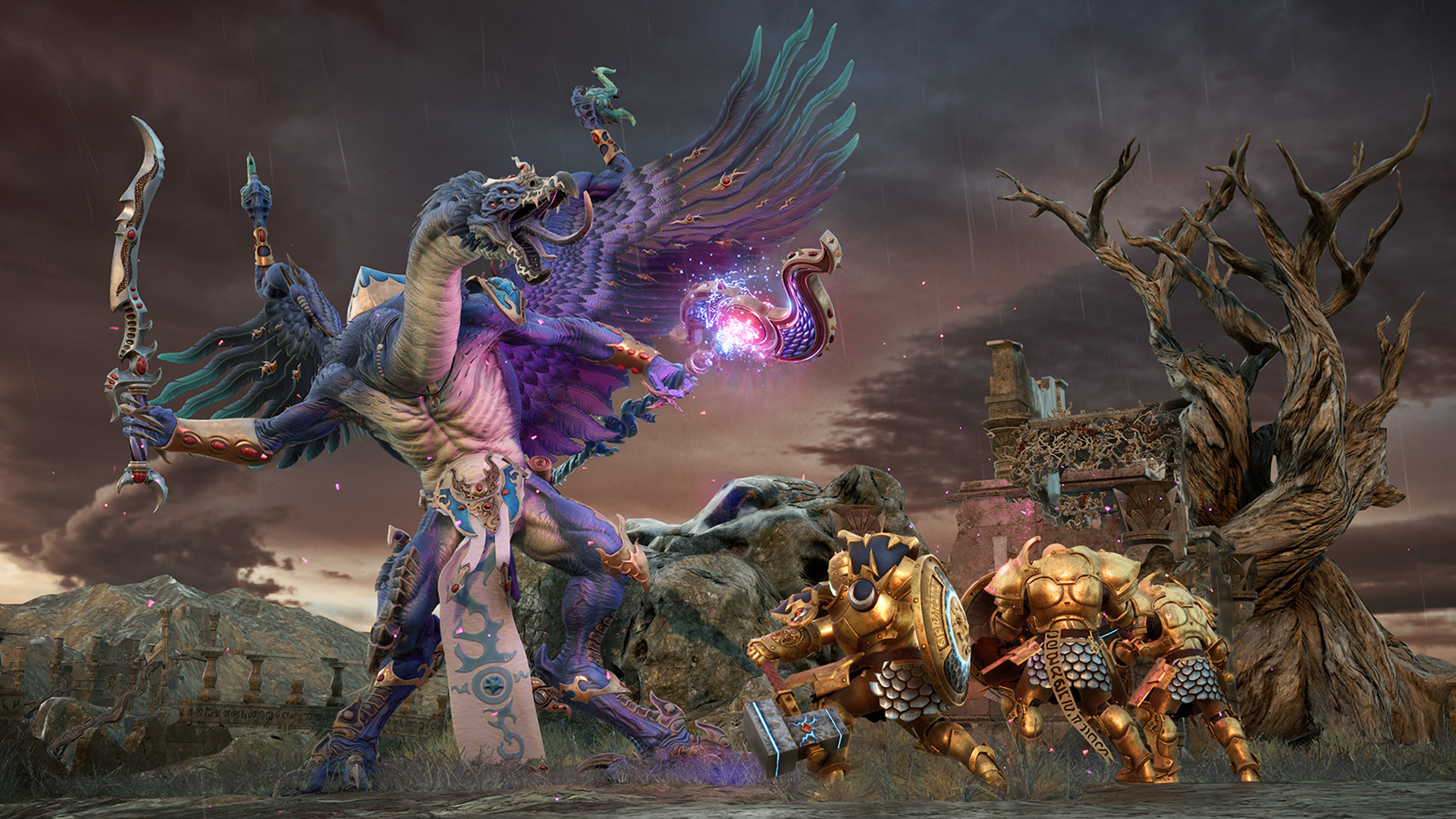
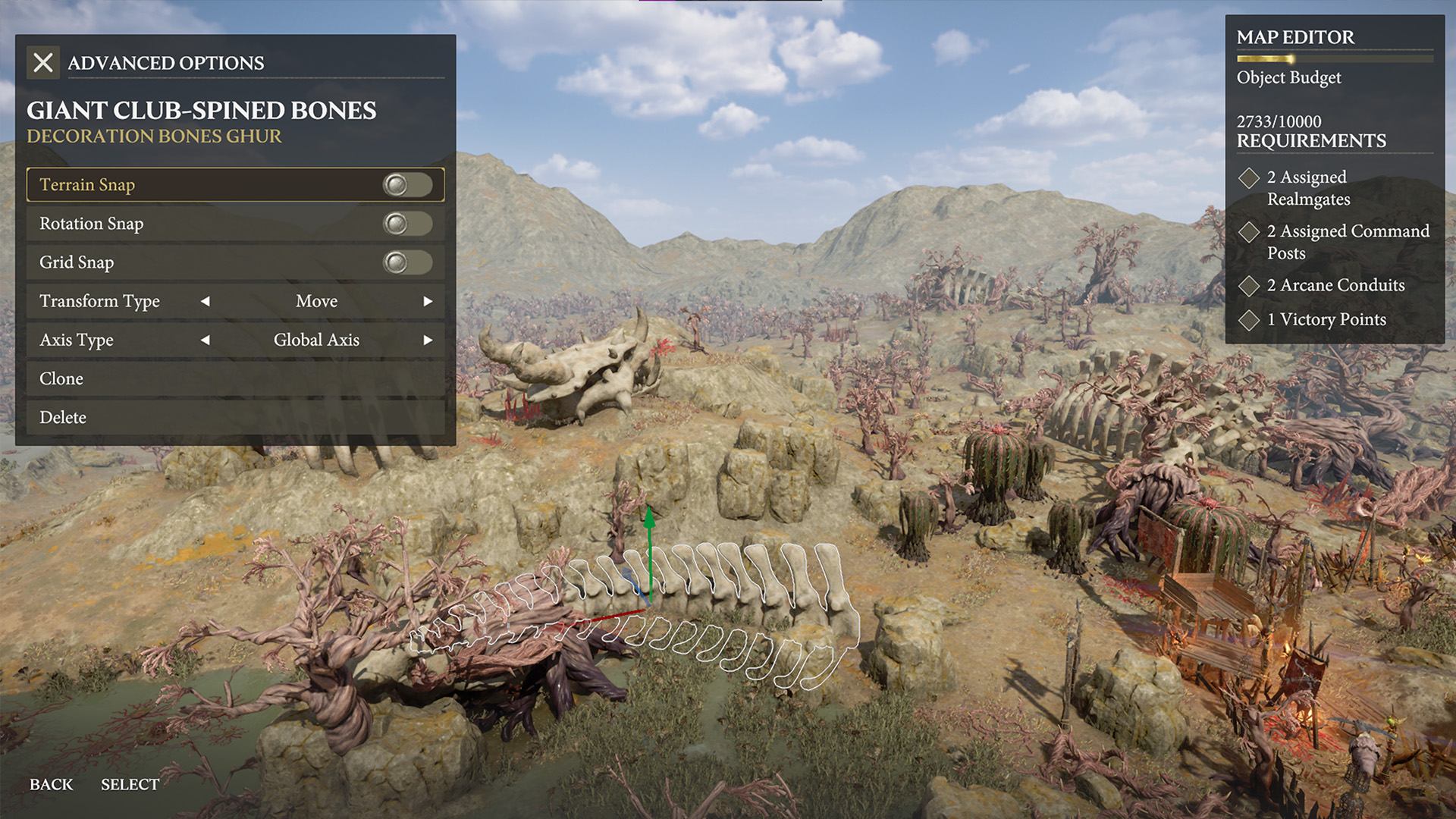
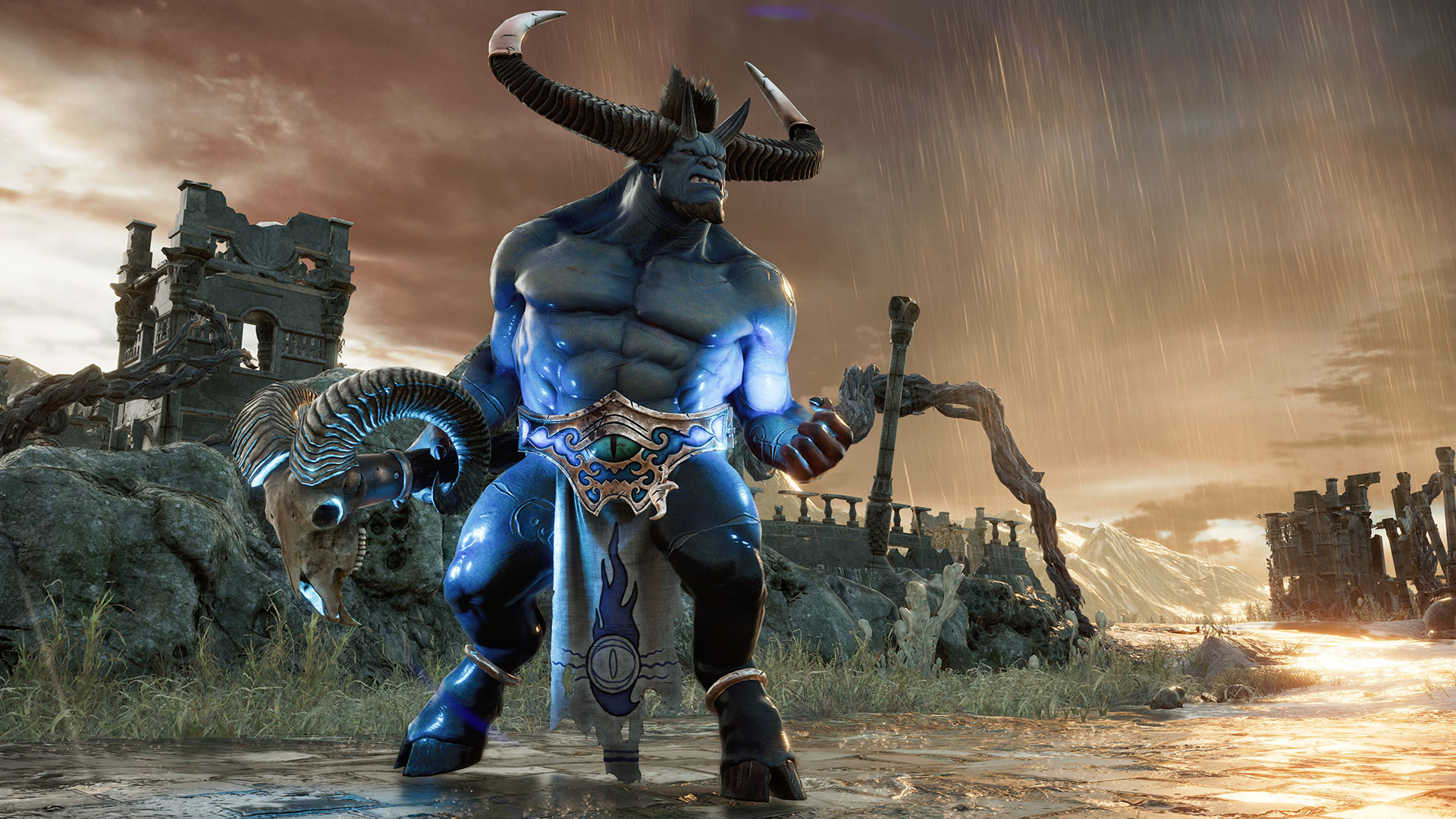


You must be logged in to post a comment.